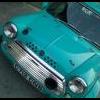After installing AFR gauge, and setting idle around 13.5, in town cruising and hard acceleration all well and fine. Highway cruising, at 70 MPH and 42,50 RPM with 3.44:1 final drive, was around 17 and sometimes leaner. Enriched idle to about 11.5, and though AFR gradually gets leaner as speed increases from 50-70 MPH, it pretty well stays below 17, but I would feel more comfortable with it a little less lean.
As a guideline I found the following in my research regarding needle profile stations:
"The first two dimensions (1 and 2) govern the idling mixture. The next five dimensions: 3 to 7 govern the pick up in fourth gear, from 30 to 70 kph (approx 20 to 40mph). A cruising speed of 60kph (35 mph) will lie somewhere around the fourth dimension, a cruising speed of 80kph (50mph) will occur around the sixth dimension. The dimensions from 8 to 13 affect top end rev range of the engine."
and
"Stations 1-4 cover idle to cruise at 4000rpm.
Stations 6-8 cover the point where you are cruising and you squeeze the throttle.
Station 12 what
Stations 1-5 are the cruise spots and when you floor it from cruise stations 6-7 are the first ones to come in"
I know none of this is conclusive or etched in stone and will vary but it seems to be a general consensus/ballpark out there from what I have found.
Given the above I think I may have found a possibly more appropriate needle than my current AAP to richen highway cruising AFR, the ADT.
There is one diameter only comparison table and a couple comparison charts with graphs, from 'Minty' and 'Haystack'.
The two needles are virtually identical top and bottom and the ADT only has slightly different diameters stations 6-11.
Then I tried to find some way of quantifying how much any specific needle diameter reduction increases fuel flow. In another forum I found a link to yet another British Mini Website offering a free spreadsheet download. Unfortunately I don't know if things have changed or my lack of tech skills prevented me from downloading it.
I did get some examples, and in the first forum someone posted some of his results. What I had never seen before that made brilliant sense to me was that, when comparing two needles, at each station the chart gave the annular area. That annular area is measured in square one thousands of an inch and is the 'ring' shaped area between the needle and the jet that the fuel must pass though
I used the concept to manually compare my current AAP needle to an ADT needle.
To start with a sample calculation.
If you have a 0.0900 jet and were to install a needle with a station 1 diameter of 0.0880" instead of one with a diameter of 0.0890" you are only decreasing the diameter 0.001", or about 10%. When you calculate the two different annular areas the smaller jet creates twice as much (100% more) area than the larger jet, and twice the amount (100% more) fuel will flow through it!
Yep, we know that would be a bad idea without the chart, but what happens lower down on the needle.
Doing the math comparing my current AAP to an ADT at station 8, the needle diameter again decreases by 0.001" as in the above example. But when you do the math this only increases the annular area by about 6.5%, only increasing fuel flow by 6.5%. As I understand it a 6.5% increase in fuel flow would knock down the AFR about one point richer, just what I am looking for.
The $27,000.00 dollar question is, would stations 6-11, especially 8, coincide with steady state cruising around 70 MPH!
So finally a question or two if I may.
Firstly, thoughts on replacing the AAP with an ADT.
Secondly, should I replace AAP with the ADT first, so if it's closer but still not right on, it should tell me which way i could profile the old AAP needles, or should I try profiling the APP needles first? At least now I have a baseline of sorts AFR wise as to where I am off and would recognize any improvements and what direction further improvements should take.
Attached Files
Edited by gdcarpenter, 25 May 2020 - 01:26 PM.
















